|
Kitbashing a 1/32 scale
RF-4C
Recce Puke
by
"Bondo" Phil Brandt
|
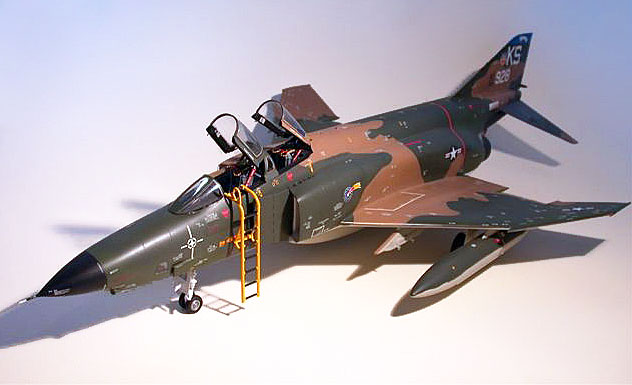
|
|
McDonnell-Douglas RF-4C
Phantom II |

HyperScale is proudly supported by
Squadron.com
Although Boy TAC WSO Bondo was a member of the F-111A fraternity for
some nine years, his introduction to fastmovers really started almost
four decades ago when in 1970 he hopped out of the nav chair of his
Dover-bound C-133A at Torrejon AB, Spain, leaving the MAC “wide-butt,
many-motor” fleet for the rush of the “down in the weeds with my hair on
fire” world of tactical reconnaissance, or as most American participants
call it, “recce” (not “recon”). The pic that adorns the display base is
of a much younger (and lighter!) Bondo in his “steely-eyed defender of
democracy” pose.
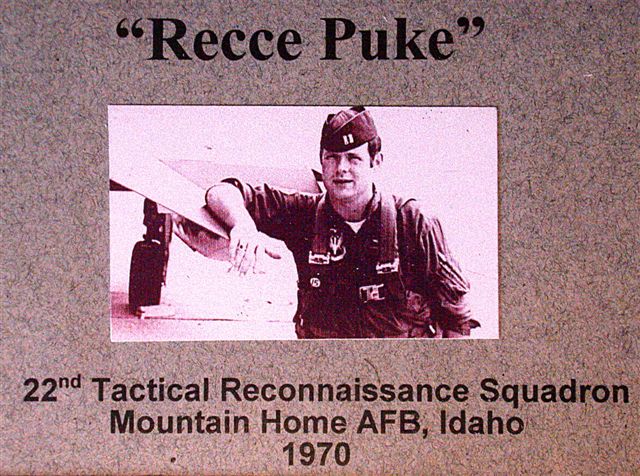
Although a lot of finished models have come off this curmudgeon’s
production line since 1966, until now I’ve really never taken the time
to do an exact representation of a bird in which I actually flew. When
the 1/32 Tamiya F-4C and Revell RF-4C hit the market, I preferred the
overall molding and detailing of the much more expensive Tamiya release,
but also bought the big recce bird. After some cursory measurements, the
integration of the recce kit’s forward fuselage to the Tamiya F-4 main
fuselage looked feasible, and surgery began.
The idea was to preserve as much as possible of what IMO was the
superior overall rendering of the Tamiya kit. Cutting of the Tamiya
forward fuselage was done so as to retain the canopy rails and
windscreen mounting surface for the use of those Tamiya components.
Seamless Sucker intake trunks were fitted. The Tamiya nosegear bay was
integrated into the Revell forward fuselage; the detailing was more
intricate than that of Revell, and now the stock Tamiya nosegear strut
could be easily fitted. AIM-7 missile mounts were faired in.
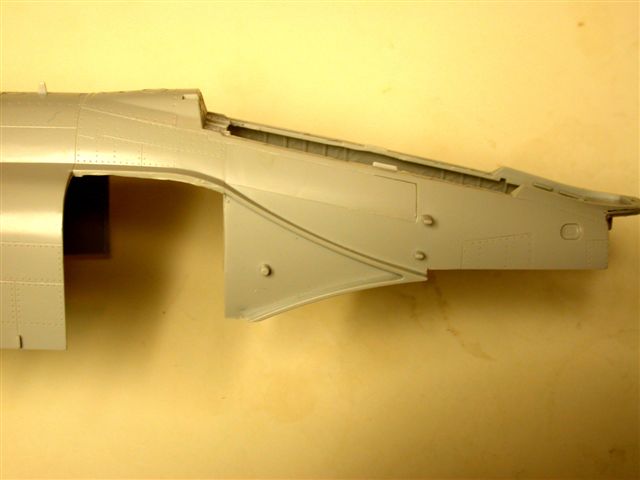
Click on the thumbnails
below to view larger images:
[../../photogallery/photo00027692/real.htm]
Wings and Externals
The wings and Sergeant-Fletcher 270 gallon outboards are stock Tamiya
items; the Royal Jet 600 gallon centerline tank was adapted from the
Revell kit. The unique, sharply-tipped inboard weapon pylons are from
the Revell release; weapon adapters on the bottom of the recce pylons
were scratchbuilt. Aux air doors were posed open. “Remove Before Flight”
tags and pins were added to the outboard tank pylons.
Cockpit
The Revell recce cockpit tub was upgraded with the Verlinden RF-4C
resin set, and the whole assembly was in turn adapted to the Tamiya
cockpit surround. Mark 7 seats are by Paragon.
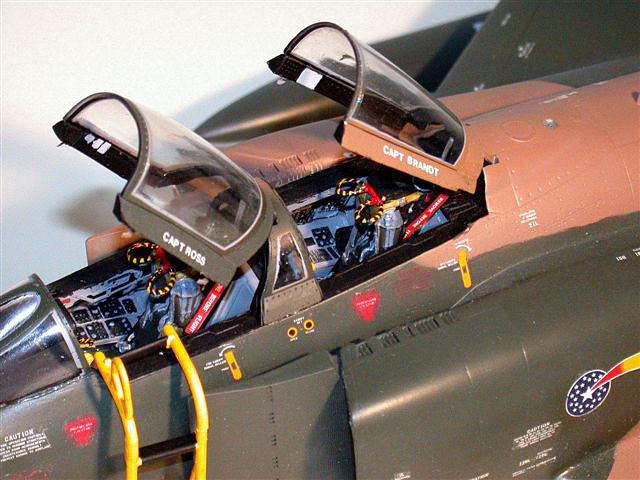
PE canopy and rail trim parts are from Verlinden and Reheat. “Remove
Before Flight” tags and associated lanyards were added to the drogue
guns on the seats.
Wheels
True Details resin replacements.
 Paint Paint
I decided to do a factory-fresh bird–yes, they really did have a “new
car” smell---from my Mountain Home AFB squadron, the 22nd TRS. The 22nd,
we were told at the time, was one of only two active USAF tactical
squadrons that could trace its history directly back, unbroken, to World
War I. In fact, on the wall of my study there’s a large B&W picture of a
SPAD XIII, “MEYER III”, parked on a snow-swept airfield in France circa
1918. Emblazoned on its fuselage is the same colorful “Vomit Comet” logo
that we sported on our jet intakes in 1970.
An aside: unfortunately, after our squadron had moved to Shaw AFB in
the Summer of 1971, the TAC commander decreed that various WWII tactical
units were to be resurrected, and we became the 62nd TRS. The 22nd TRS
name and logo “went away” to an ignominious end as a, get this, C-130
drone squadron at Davis Monthan AFB.
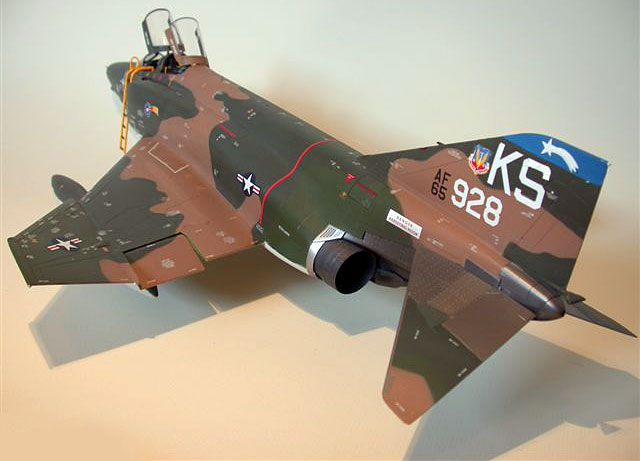
The TAC three-tone camo scheme was done in Testor's water-based acrylic,
and the undersides are in camouflage gray. Many iterations of masking
with the edges turned gently up were necessary to achieve the proper
overlap of colors, not too “soft”, not too “hard.”
Metal shades courtesy of Alclad II.
Decals and Other Markings
The 22nd TRS comet logo was obtained from a Dragon 1/48 WWI SPAD kit;
the 1/48 size actually worked out correctly for the 1/32 model. The
numerous white stencils–our new birds appeared as if a light snow had
fallen on ‘em–were done by Icarus and are a relatively new, and welcome,
product. Black underside and pylon stencils are by ISRA Decal. The
completeness and printing of both decal stencil sheets is outstanding!
Tail codes and national insignia are from Aeromaster sheets. Another
aside: I heard that a (perhaps joking) comment was made at the Anaheim
nats bringing into question the accuracy of the “KS” tail code, since
all F-111s ever based at Mountain Home carried the well known “MO”
designation. I can assure one and all that, between 1966 and 1971, when
TAC recce ruled at Mountain Home, tail codes were “KS” (22nd TRS, the
only operational squadron); “KT” (7th TRS, a RTU); and “KR” (10th TRS,
also a RTU).
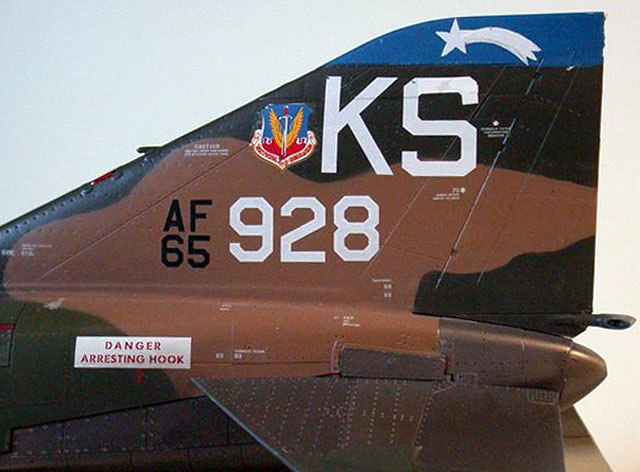
The distinctive Cold War NATO “asset” logo on the left forward fuselage
side is a combination of kitbashed decals and hand painting, as are the
white comets on the tip of the tail.
Aircrew member names in very small font on the canopy sides are dry
transfer.
This kit had its one and only competitive outing at Anaheim in August
and, being on the table all by itself in 1/32 Aircraft Conversions–I was
waiting with baited breath to see if some modeling heavy hitter such as
Alan Hess would show up with an entry in this category--scored. Hey, as
we say in the fighter business, “A kill’s a kill”! :)
Click on the thumbnails
below to view larger images:
[../../photogallery/photo00021268/real.htm]
Model, Images and
Text Copyright © 2007 by "Bondo" Phil Brandt
Page Created 22 October, 2007
Last Updated 24 December, 2007
Back to HyperScale
Main Page
|
Home
| What's New |
Features |
Gallery |
Reviews |
Reference |
Forum |